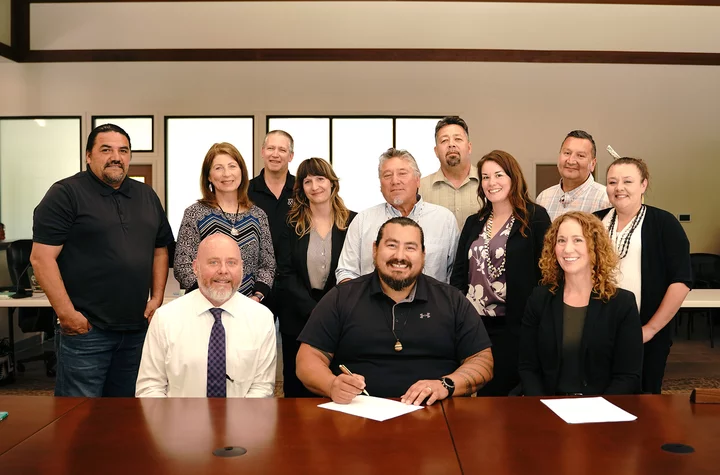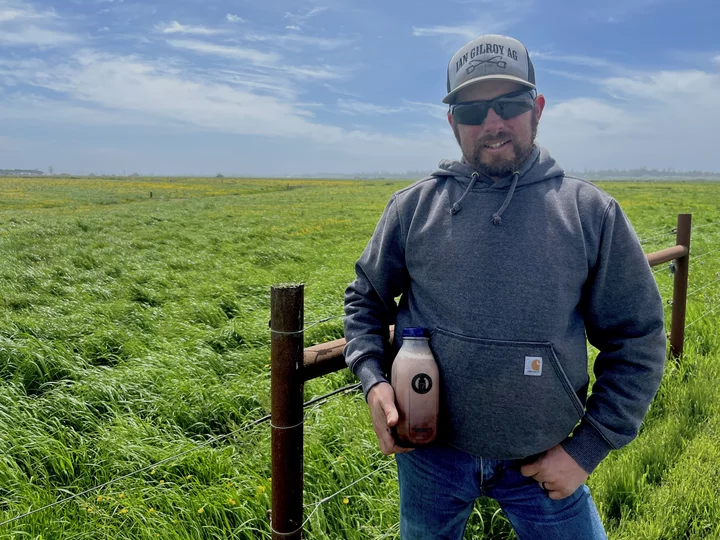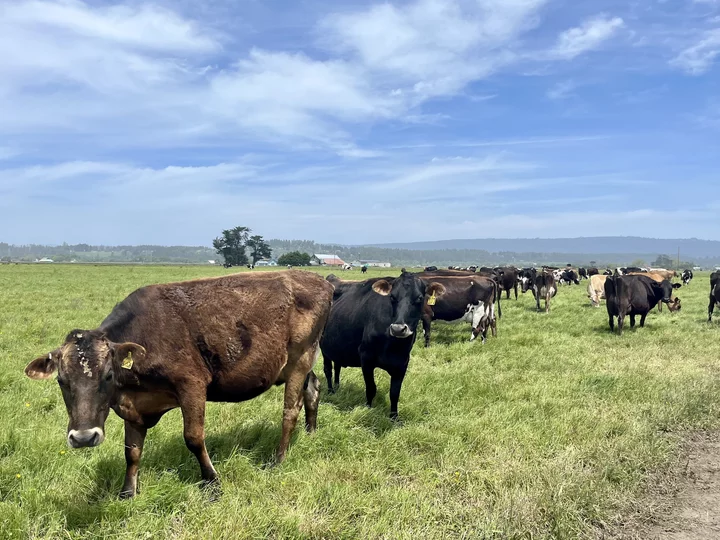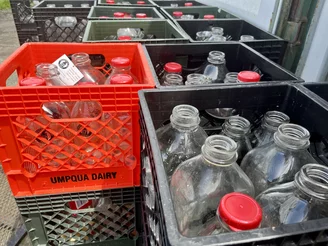OBITUARY: Gary D. Hallum, 1951-2023
LoCO Staff / Thursday, May 25, 2023 @ 6:56 a.m. / Obits
Gary D. Hallum died unexpectedly in his sleep on May 11, 2023 at the
age of 71. He was the oldest of four children to his parents Linzie
and Virginia Hallum.
Not long after graduating from Alisal High School, Gary married Lauran Peterson and they had two children, Kim and Dan. They took trips to Disneyland, Yosemite and even panned for gold on a camping trip. Gary worked at Spreckels Sugar Company. One day he forgot to remove his watch before work and lost it in the sugar. He said that somebody got a nice watch with their sugar.
Gary was a jack of all trade. He did everything from being a caretaker to driving truck. He also deconstructed houses for the lumber and build a huge two story barn and a tree house. If anyone needed help, he would be there. He helped take care of his grandfather Robert, his mother Virginia and his step-father Alvy. There wasn’t anything that he couldn’t do.
Later in life Gary met Missy and they married and had a son, Ryan. Gary wanted the best for his family and left the fishing docks of Moss Landing to work in wastewater management. He worked hard and studied hard to pass the required tests.
In retirement, Gary, Missy and Ryan moved to Eureka. Gary loved cutting and polishing rocks, cross pollinating peppers for varieties that were both tasty and spicy and he loved his animals. Gary and Missy became parents of many rehomed birds including a duck. Gary had a special bond with them. Gary was also gifted at cross stitch. His works are mesmerizing.
Gary is preceded in death by with parents, Linzie and Virginia and his brother Keith. He is survived by his wife Missy, his children, Kim, Dan and Ryan and his sister Star, brother Chuck and his nephew Dustin. Gary was much loved and will be very missed.
Gary wished to forgo services.
###
The obituary above was submitted on behalf of Gary Hallum’s loved ones. The Lost Coast Outpost runs obituaries of Humboldt County residents at no charge. See guidelines here. Email news@lostcoastoutpost.com.
BOOKED
Today: 8 felonies, 11 misdemeanors, 0 infractions
JUDGED
Humboldt County Superior Court Calendar: Today
CHP REPORTS
7400 Mm101 N Hum 74.00 (HM office): Assist with Construction
ELSEWHERE
RHBB: Power Outage for 183 Customers in Covelo After Acura Crashes into Utility Pole
Governor’s Office: Governor Newsom creates new housing and transportation using nearly $1 billion paid by big polluters
Governor’s Office: Cannabis crackdown: State officials seize 58,350 illegal cannabis plants worth $57 million in November
HUMBOLDT TODAY with John Kennedy O’Connor | May 24, 2023
LoCO Staff / Wednesday, May 24, 2023 @ 4:56 p.m. / Humboldt Today
News time! Today: Scams, curious CEOs, non-censure of a supervisor and much more!
And don’t forget about today’s poll!
Yurok Tribe Partners With County, Courts on ‘Culturally Informed Diversion Program’ Focused on Rehabilitation
LoCO Staff / Wednesday, May 24, 2023 @ 4:45 p.m. / Courts , Tribes
Front row: Presiding Judge Humboldt County Superior Court Gregory Kreis, Yurok Vice Chairman Frankie Myers and Humboldt County District Attorney Stacey Eads. Middle row: Yurok Council Members Ryan Ray and Sherri Provolt, Yurok Court Staff Attorney Amber Miller, Yurok Court Judge William Bowers, Yurok Court Director Jessica Carter and Yurok Council Member Mindy Natt. Back row: Yurok Council Members Toby Vanlandingham, Wes Crawford and Phillip Williams.
###
Press release from the Yurok Tribe:
Today, the Yurok Tribe and Humboldt County Superior Court and Humboldt District Attorney’s Office signed an agreement that will allow adult Yurok citizens facing certain criminal charges an opportunity to defer prosecution and instead enroll in the Yurok Wellness Court’s comprehensive, culturally centered Wellness Diversion program.
“The primary goal of this program is to provide each participant with the ability to choose a new life path and become a contributing member of the community,” said Yurok Chief Justice Abby Abinanti. “The holistic program will help individuals confront the root cause of their irresponsible behavior and move forward in a good way.”
“With the agreement we memorialized today, I anticipate many successful outcomes from the Yurok Wellness Diversion Program— a program of opportunity and accountability, guiding eligible participants towards a productive, law-abiding life,” added Humboldt County District Attorney Stacey Eads.
Under this agreement, Yurok citizens charged with specific misdemeanor and felony violations of the penal code may be eligible for Yurok Wellness Diversion pursuant to stipulated agreement with the District Attorney or Court-initiated misdemeanor diversion via California Penal Code Section 1001.95.
The Humboldt County Superior Court, in collaboration with the Yurok Tribal Court, district attorney and defense counsel, will determine if the individual is eligible to participate in the Yurok Diversion Program.
Only adult Yurok citizens charged with misdemeanors and certain non-violent felonies may take part in the program.The Yurok Tribal Court, along with the District Attorney or Superior Court, will determine if the individual is eligible to participate in the Yurok Diversion Program.If the individual qualifies and consents to diversion, the Yurok Tribal Court will develop a tailored wellness plan for the participant and oversee its implementation through culturally integrated case management.
The plan may include: referrals for addiction and mental health treatment, Yurok cultural engagement activities, educational and vocational training, job placement, housing assistance and additional types of supportive services if needed. The Yurok Wellness Court will also perform home visits and drug screening. The diversion period may last 6 months to two years.
Throughout the duration of the diversion period, Wellness Court staff will send monthly reports on the participants’ progress to the district attorney and defense counsel. At the end of the diversion period, or upon earlier graduation from the Yurok Wellness Court, the criminal charges will be permanently dismissed. If the participant routinely fails to perform the actions outlined in the wellness plan, the case will be terminated by the Yurok Wellness Court and the original charges may be reinstated by the prosecutor.
The Yurok Diversion Program Memorandum of Understanding (MOU) will open the door for other Tribes to start similar programs. The agreement may serve as a starting point for negotiation and/or a template for tribal diversion terms. Any tribe with a tribal wellness court may seek to begin a tribal diversion program and enter a Memorandum of Understanding with a district attorney and superior court.
Representatives from the Yurok and Hoopa Tribal Courts, Humboldt County Superior Court, Humboldt County Conflict Counsel, Humboldt County Public Defender’s Office, and Humboldt County District Attorney’s office collectively developed the procedures for Yurok Tribal Diversion Program.
On a case-by-case basis, the Humboldt County District Attorney’s Office and Superior Court have been diverting cases to the Yurok Wellness Court since August of 2021. The MOU will streamline the diversion process. To date, four Yurok citizens have completed the diversion program and two more are successfully moving through it.
In addition to Wellness Diversion, the Yurok Tribal Court offers an Adult Wellness program for adult applicants with pending charges or supervision violations, civil violations in the Yurok Tribal Court, or other agency agreement or court order requiring participation in the Wellness Court.
The Yurok Tribal Court also co-administers Joint Jurisdictional Family Wellness Courts in the Humboldt and Del Norte Superior Courts. Presided over by tribal and state court judges, the Joint Family Wellness Court helps families break the cycle of addiction.
A Family Wellness program is also available in the Yurok Tribal Court for families with reunification-type cases who are ineligible for Joint Jurisdiction. The Yurok Wellness Court has helped dozens of tribal citizens transform their lives. Many of the court’s clients have secured full-time employment, reunited with their children and reengaged with their culture.
To learn more about the Yurok Wellness Court, please visit https://yuroktribalcourt.org/programs/wellness-court/
FERREIRA & SON: Meet the Rancher Who’s Fighting ‘Tooth and Nail’ to Keep Arcata’s Last Remaining Dairy Alive
Stephanie McGeary / Wednesday, May 24, 2023 @ 3:06 p.m. / Business
Got (chocolate) milk? Darin Ferreira in front of his fields in the Arcata Bottoms | Photos by Stephanie McGeary unless otherwise noted.
###
For Darin Ferreira, a third-generation rancher on his family’s dairy farm in the Arcata bottoms, running a dairy is a labor of love. He is truly passionate about his work, which is what keeps him going in a business that is definitely not easy to keep afloat.
“This is my life,” Ferreira told the Outpost during a tour of the Ferreira & Son Dairy ranch on Lanphere Road. “Everybody’s got a hobby. This is mine. This is where I spend all of my money.”
Ferreira’s grandfather, Louis, moved to California from the Azores in 1918, a time when the North Coast’s dairy business was booming, and started a dairy ranch in Ferndale. After the Eel River flood of 1955 destroyed most of the Ferndale ranch, the family moved to the Arcata property, where Louis worked until he passed away in 1982, at which point the ranch was taken over by his son, Louis Junior. Darin, in turn, took over the dairy when his father passed away from cancer in 2018 and now runs what is the last remaining dairy in Arcata.
When Ferreira’s mother, Judi, married into the family in 1971, she told the Outpost, there were at least 30 dairies in the Arcata area. But over the decades nearly all of Arcata’s dairies have gone out of business, four of them within the last five years. By 2022, there were only three remaining diaries and two of them closed last winter, Judi said.
And it isn’t just Arcata that has been seeing dairy farms disappear. Factors like the increased price of land, the rigorous permitting processes and drought have caused dairy farming in California to decline significantly, with many farmers either closing up entirely or moving out of the state.
With inflation always increasing overhead costs, Ferreira said, it is very difficult for dairies, especially small ones, to be profitable. In addition to inflation, he added, there just aren’t as many people in the younger generations who want to go into dairy farming. So many dairies have gone under simply because the farmers grow old and have no one to take over for them.
The herd.
For Ferreira, there was never a question of not taking over the family dairy. After leaving Humboldt for many years and working on a ranch in Montana, Ferreira returned to Arcata when his dad got sick and has spent the last five years doing everything he can to keep Ferreira & Son operational. This meant making some big changes.
“It wasn’t until the day my dad passed away that it really kicked in that ‘Hey, this is up to me,’” Ferreira said. “All I knew was that if I was gonna keep the ranch afloat, I needed to bottle my own milk and cut out the middleman.”
Before the third-generation Ferreira took over, his family’s dairy sold its milk to dairy co-ops, such as the Humboldt Creamery, Rumiano Cheese and Organic Valley. For more than 10 years, the Ferreiras sold their milk to Organic Valley, but eventually took an offer from the company to buy out their shares.
The creamery
In 2021 Ferreira built a small on-site creamery out of two shipping containers and started pasteurizing, bottling and distributing Ferreira & Son organic milk, which you can now find on the shelves at many local grocery stores. Though Ferreira had learned everything about dairy ranching from his father, he knew virtually nothing about running a creamery and the entire process has been self-taught.
And though it took some trial and error, the creamery is now running smoothly and Ferreira produces between 500 and 700 bottles (or about 200 to 300 gallons) of milk per week. In addition to the regular milk, Ferreira & Son also produces chocolate milk, which is mixed on-site using Ghirardelli chocolate.
All the milk comes from Ferreira’s herd of 70 cows, which are a mix of Holstein, Jersey and brown Swiss cattle. (Many of them are holstein/ jersey cross breeds). The cows graze on about 80 acres of grass — a mix of red clover, white clover and ryegrass — and are 100 percent grass-fed. Ferreira doesn’t buy any feed for the cows, which is another way he cuts down on costs, he said, and it also helps keep the cows healthy.
Though it is a fairly small operation, running the dairy and creamery takes a lot of work. Ferreira hires someone else to do the milking (12 cows can be milked at a time) and just recently hired a full-time farm hand to help with the other ranching duties. Ferreira pasteurizes and bottles the milk, cleans and sanitizes the bottles for reuse and also does the milking on the weekends when the hired milker is off. Ferreira’s mother, Judi, is in charge of all of the bookkeeping, as well as printing the tags that go on the bottles.
Keeping the business small and mostly family-run has been a great way to keep costs low while Ferreira was taking over, he said. But he still has plans for growing the business. The milk has been selling well and the dairy is already outgrowing the tiny creamery. Ferreira is currently working on plans for a bigger, better creamery and is just working to get grant funding from the USDA to build it. He hopes to have the new creamery up and running within the next three years. At that point, Ferreira said, he plans to start producing and distributing ice cream. Once those products are doing well, he eventually plans to add cheese to the list.
Ferreira is also in the process of starting a hay business. The farm is actually located on roughly 300 acres of farmland, and with the cows only needing a portion of that for grazing, the rest can be used for hay and silage. Because Ferreira also has the dairy for income, he said, he will be able to charge other farmers a very reasonable price for hay.
Coming up with these different ways to diversify the business and creative ways to keep costs down is how Ferreira said he is keeping the dairy running. Just like his grandfather and father, Ferreira wants to build something that he can pass on to his own children (he has one 14-year-old son and a baby on the way), if that’s something that they want, he said.
“I didn’t want my grandfather’s and father’s hard work to be for nothing,” Ferreira said. “And that’s why everyday I fight tooth and nail to make sure that their legacy lives on. Ranching is more than just work for me, it’s sentimental. It’s a way of life.”
A bottle of Ferreira & Son organic, grass-fed milk | From the company’s website.
New Report Says Cal State Has $1.5 Billion Funding Gap, Suggests Tuition Hikes
Mikhail Zinshteyn / Wednesday, May 24, 2023 @ 2:19 p.m. / Sacramento
Members of Teamsters, CSUEU, UAW 4123, and CFA Faculty gathered to ask for fair wages outside the CSU Chancellor’s office in Long Beach on May 23, 2023. Photo by Lauren Justice for CalMatters.
The nation’s largest public four-year university is presently incapable of affording itself.
A 70-page report nearly a year in the making by leaders of the California State University details the massive gulf between the money the system currently generates from tuition and receives in state support and the actual costs of educating its nearly 500,000 students and employing 60,000 workers.
All told, CSU’s revenues account for only 86% of the system’s overall costs — a gap of nearly $1.5 billion in 2021-22. Support for student services is the least funded relative to costs, at just 68%. The analysis is based on a highly technical set of assumptions and system data. That gap doesn’t even include Cal State’s roughly $6 billion backlog in construction maintenance projects.
A central premise of the report is that the CSU cannot afford to do the things it should be doing to help students succeed.
“The model explains why there never seems to be enough money to pay for what the universities think they need,” the report states.
As a consequence, ongoing tuition hikes are likely forthcoming. Likely more system tumult awaits, as unions are threatening to strike.
The report’s findings were presented to the Cal State Board of Trustees today.

Emma Joslyn, center, a member of UAW 4123, and Nora Cisneros, right, with CFA, during the rally. Members of Teamsters, CSUEU, UAW 4123, and CFA Faculty gathered to ask for fair wages outside the CSU Chancellorís office in Long Beach on May 23, 2023. Photo by Lauren Justice for CalMatters
“This is a lot like climate change,” said Julia Lopez, a CSU trustee and co-chairperson of the working group that wrote this report. “If we don’t heed the warning signs right now, we’re going to find ourselves in a world of hurt down the line. So that’s what we’re trying to do, to get ahead of that.”
The Cal State’s revenues from tuition and state support will be 29% to 41% less than what the system needs by 2030 unless the system finds new sources of money, warn the report’s authors, a mix of CSU trustees, provosts, campus presidents, senior system staff, a leading professor, outside consultants and the president of the student association. And that’s “even with aggressive assumptions about increases in state General Fund and tuition.”
These cost gaps don’t necessarily mean cuts to key services are imminent. “It’s not really about what cuts we’re going to make, it’s … opportunities that we do not have to invest in additional things that we should be investing in,” said Jeni Kitchell, executive budget director for the CSU.
A major cost driver for the CSU is its status as a national engine of social mobility. Its students are often low-income or the first in their families to attend college, and require more academic support to graduate, as well as added money to afford food, housing, mental health and other basic needs, Lopez said.
“If we don’t heed the warning signs right now, we’re going to find ourselves in a world of hurt down the line.”
— Julia Lopez, CSU trustee
Part of the report’s analysis included how much it would cost to improve the graduation rates of low-income students and students of color by examining the few campuses that have made the most progress in closing equity gaps. The analysis also introduced new data that’ll be closely watched, like the cost of providing each major.
This sobering analysis echoes what the state’s nonpartisan bean counters, the Legislative Analyst’s Office, said in January: Cal State’s tuition and state support will fall $100 million short of its likely costs in 2023-24.
But the solutions the report describes will be bitter pills to swallow. Annual tuition hikes are necessary to increase revenue for the CSU, the report argues, reversing course for a system that has raised tuition only once in the last 12 years.
Even steep tuition hikes, however, won’t be enough to stabilize CSU’s finances.
“From the student perspective, I don’t think we’re ever going to be fine with tuition increases.”
— Krishan Malhotra, Cal State Student Association president
CSU’s trustees should adopt a tuition-hike plan by September, the report said.
The CSU Chancellor’s office is doing just that. It will present a tuition hike to the board in July after consulting with the Cal State Student Association, a system requirement. The plan is to have the board approve a tuition-hike policy in September that would kick in fall 2024, said Steve Relyea, CSU’s chief financial officer.
“From the student perspective, I don’t think we’re ever going to be fine with tuition increases,” the association president, Krishan Malhotra, said in an interview Tuesday.
But a predictable model that students can budget for and that sends more financial aid back to students, “there’s definitely benefit there.”
What tuition hikes would look like
How much more revenue the CSU would generate from tuition hikes depends on whether the system continues its enrollment slide or begins attracting additional students. Another factor is whether tuition goes up 3% for every student annually, or increases once by 5% for every new incoming class of students, similar to the policy the University of California adopted in 2021. The Legislative Analyst’s Office credits those tuition hikes for UC’s stable finances.
Under either model, revenue soars by as much as $765 million annually compared to no tuition increase at all by 2030 — assuming the trustees approve tuition hikes for 2025, the report said.Still, tuition hikes alone may not be enough to plug CSU’s operating hole. The system’s revenues were $1.5 billion below total costs in 2021-22, according to the report. A tuition hike would only generate between $150 million and $200 million in its first year.
For new undergraduates, the hikes proposed by the report would equate to a tuition increase of $5,000 or $8,000 over a five-year period by 2030.
Any tuition hikes would primarily affect middle class students: 60% of Cal State’s undergraduates don’t pay tuition because they receive state and campus grants due to their low family incomes.
The middle class families most affected are getting more financial aid through the state’s new expanded Middle Class Scholarship.
CSU’s California students are charged an average of $7,550 for tuition and fees, among the lowest in the country; the national average for public universities is nearly $11,000. And because of state and campus financial aid, more than half of students don’t pay any tuition. The CSU already routes one third of its budget to student aid.
At least one lawmaker who has pushed aggressively for more student financial aid told CSU officials to increase tuition rather than coming to the state for more money, especially as the state faces a $31.5 billion budget hole.
“There’s something you can do which is moderate and predictable,” Assemblymember Kevin McCarty, a Democrat from Sacramento who is chairperson of the budget subcommittee on education, said during a March hearing. “You can do what the UC did.”
Worker frustration
The CSU needs money now, in no small part due to workers signaling they’re ready to go on strike if they don’t get raises soon.
Scores of educators and other staff assembled outside the CSU headquarters Tuesday in Long Beach to kick off a “summer of solidarity” among CSU unions. Several dozen poured into the public gallery during the trustees meeting Tuesday. For most of the nearly two-hour public comment period, union members inveighed against unfair pay and stalled labor contract negotiations with CSU officials.
“We’re here to sound the alarm, trustees, because we are on a collision course with a labor dispute of historic proportions,” Jason Rabinovitz, top officer for Teamsters Local 2010, told CSU trustees Tuesday. “And the reason is that you’ve been paying workers too little for too long and the situation is coming to a head.”

Kevin Wehr, California Faculty Association’s Vice President and Professor at California State University – Sacramento, speaks to Presidents at CSU, Leadership, and the Board of Trustees during public comment to ask for fair wages outside the CSU Chancellor’s office in Long Beach on May 23, 2023. Photo by Lauren Justice for CalMatters
The faculty union, the largest within the system representing about 30,000 workers, wants 12% raises across the board for this fall.
That would cost the CSU $318 million more annually, a system spokesperson wrote.
But the faculty union argues the CSU has the money. Its research team points to the $472 million in excess revenue above costs that the system generated in 2021-22.
“Any surplus is considered one-time reserves,” CSU spokesperson Amy Bentley-Smith wrote in an email. “Salary increases are ongoing, and using one-time reserves to pay ongoing costs is not fiscally prudent.”
“We’re here to sound the alarm, trustees, because we are on a collision course with a labor dispute of historic proportions.”
— Jason Rabinovitz, top officer for Teamsters Local 2010
The union leadership also flags at least $2 billion that the CSU has placed into its investment accounts since 2022, wondering where that money came from and why it can’t be used for wages and educational expenses instead.
Bentley-Smith pointed CalMatters to a CSU explainer on its investment and reserve strategies. “Designated balances and reserves accumulate annually primarily from tuition, fees, and other revenues in excess of annual expenses,” the explainer reads. The money is meant to support campuses in times of economic downturns and natural disasters, as well help cover “student housing, campus parking, student unions, health facilities, university and educational operating activities, among others.”
Could the faculty union strike by this fall?
“It’s not off the table,” said Kevin Wehr, vice president of the union and a professor of sociology at Sacramento State.
“Salary increases are ongoing, and using one-time reserves to pay ongoing costs is not fiscally prudent.”
— Amy Bentley-Smith, CSU spokesperson
Staff unions demand the CSU adopt the findings of an independent report — funded by lawmakers — that would place staff on salary steps consistent with their skill and experience. The so-called Mercer report found that Cal State staff earn about 12% less than workers in their fields at other job sites and campuses.
Doing so would come with a series of 5% raises. Such an overhaul would cost the CSU $287 million in its first year and nearly $900 million annually after a decade. Staff unions say the CSU is only offering 2% raises.
“I’m living off of credit cards at this point,” said Dennis Sotomayor, 52, a member of Teamsters Local 2010 union who works as a maintenance mechanic at Cal State Los Angeles. He earns about $60,000 a year, he said.
State support already high
Cal State’s fiscal shortfall comes even despite a recent pledge by Gov. Gavin Newsom to provide it with five years of 5% growth in state support for the system’s operations, totaling more than $1 billion. Newsom has made identical promises to the UC.
Despite the massive state budget deficit, Newsom is still promising the second installment of those raises for the 2023-24 fiscal year, which he and lawmakers must approve by the end of June.
Newsom could have won himself more political points with unions by specifying that his 5% raises should go to employee pay and benefits, a senior aide told CalMatters. But Newsom didn’t do that, giving CSU leadership the task of figuring out where the money should go.
The faculty union has written to Newsom asking that a fixed amount of any state support go directly to student instruction, which would benefit faculty.
“We have to set the (university) systems up for success to serve all aspects of each of their respective ecosystems,” said Ben Chida, chief deputy cabinet secretary for the governor and who oversees education policies. “And that can’t be a decision that gets nickeled and dimed out of the governor’s office.”
Enrollment uncertainty
Further crimping the system’s finances is a sudden drop in enrollment: The state gives money to Cal State for every California undergraduate it enrolls.
Enrollment is also tied to tuition. At current rates, tuition revenue will drop 9% by 2030 if the CSU loses about 2% of its students annually — the same rate of projected enrollment loss at California’s high schools.

From left to right, students Gursirat Kaur, Prabhjot Kaur and Ramit Johal walk across campus to their next class at Fresno State in Fresno, on Feb. 7, 2022. Photo by Larry Valenzuela for CalMatters
The system chancellor’s office has already devised a plan to pull some state funding from under-enrolled campuses to instead flow to campuses that are meeting their enrollment targets. If that incentive prompts campuses to recruit more students, then an annual 1% growth in enrollment boosts tuition revenue by 5% by 2030, the report said.
But with a national slowdown in students heading to college, there may not be enough students to go around. Plus, educating students is more expensive than in previous years, as today’s college learners are typically lower-income and require more financial aid and money for sudden homelessness, chronic hunger and mental health support.
“There’s been a historical shift in services provided by the county and state that are now the presumed obligation of higher education,” the report said. “While the kinds of services provided to our students are fundamental and necessary, they have come at a cost not fully reimbursed by the state or federal government.”
###
CalMatters.org is a nonprofit, nonpartisan media venture explaining California policies and politics.
What the Heck’s Going on With Broadway in Eureka? Caltrans’ ‘Pop-Up Demonstration,’ Explained
Ryan Burns / Wednesday, May 24, 2023 @ 1:59 p.m. / Transportation
Photo courtesy of Caltrans.
###
Anyone who’s traveled on Broadway in the last week and a half or so has no doubt noticed some curious new lane dividers and diversions. That’s because Caltrans is once again exploring ways to make this ugly, traffic-clogged throughway less terrible.
The temporary installations, known as “pop-ups,” are intended to test some proposed improvements prior to possible construction. Caltrans put some up last June, and a new set arrived on May 12.
Here’s more info from the agency:
Caltrans is continuing to test pop-up demonstrations along the Broadway portion of U.S. 101 in Eureka. This includes temporary cone-like delineators and paint to analyze proposed improvements. Please note that Caltrans’ work north of Wabash is not associated with the pop-up demonstrations.
The Broadway Corridor has high rates of fatal and injury collisions. According to the 2017 data from the California Office of Traffic Safety, the Broadway Corridor ranks number one throughout the state for total fatal and injury collisions when compared to 93 other similar facilities.
Caltrans has a vision to eliminate fatalities and serious injuries on California’s roadways by 2050 and provide safer outcomes for all communities. This vision is planned to be achieved through the adoption of the Safe System approach, which includes six principles: deaths and serious injuries are unacceptable, humans make mistakes, humans are vulnerable, responsibility is shared, safety is proactive, and redundancy is crucial.
The Broadway Pop-Up Demonstrations are testing safety countermeasures proven to reduce serious collisions. While some of these test improvements may be an adjustment — especially for motorized users — there are many people who walk or cycle on Broadway to commute to work, exercise, shop, take children to parks, access the coastal trail, and satisfy any number of other daily transportation needs. Even one death on our transportation system is unacceptable.
Have you interacted with the pop-ups? Please take the survey! Feedback about the demonstrations will help decide how Broadway will look in the future. Travelers interacting with the pop-ups are encouraged to read more and provide feedback via a survey at broadwaypopups.com.
Broadway pop-ups and other improvement projects are being planned and designed in close coordination with our partners including the City of Eureka, Humboldt Transit Authority, Humboldt Bay Fire, Humboldt County Association of Governments, and community-based organizations.
For additional updates on these projects and others, follow Caltrans District 1 on Facebook, Instagram, and Twitter. You can also check out the District 1 Current Projects page for more information on these and other projects.
Eureka Motel Killer Pleads Guilty, Leads Police to Victim’s Remains in Exchange for 25-Year-Sentence, District Attorney’s Office Reports
LoCO Staff / Wednesday, May 24, 2023 @ 1:51 p.m. / Courts
Press release from the Humboldt County District Attorney’s Office:
On May 2, 2023, defendant Jason Miller, age 42, pled guilty to voluntary manslaughter for the April 15, 2021, killing of Kiera Foley, age 32, in Eureka. The defendant also pled guilty to assault with a firearm on a second victim, and assault with force likely to produce great bodily injury on a third victim.
After entering his plea, the defendant met with the Humboldt County District Attorney’s Criminal Investigations Division to provide information about the location of Ms. Foley’s remains. In collaboration with the Eureka Police Department, operations were conducted to recover Ms. Foley’s remains at a location on the outskirts of Eureka. The recovery was completed on May 10.
Ms. Foley’s family has been notified and will soon be provided with the opportunity to lay her to rest.
The Humboldt County District Attorney’s Office would like to give thanks and recognition to our local Humboldt County K-9 search and rescue dog teams; the Cal Poly Humboldt Anthropology Department; the CA Department of Justice; and the Eureka Police Department, for their assistance with this recovery.
On August 24, Miller is expected to be sentenced, pursuant to agreement, to serve 25 years in prison.
###
PREVIOUSLY:
- MISSING: Humboldt Woman Disappears Under ‘Unknown Circumstances’
- MISSING: EPD Seeking Woman Last Seen in Eureka in April
- Already Incarcerated Suspect Arrested for Alleged Murder of Missing Woman Kiera Lynn Foley
- MILLER PRELIM: Witnesses Say Suspect in Eureka Murder Showed Them Victim’s Body, Confessed to Dismembering and Burying Her
- MILLER PRELIM: Murder Suspect Can Stand Trial, Judge Rules, Despite the Fact That No Body Has Been Found
- TODAY in COURT: Eureka Murder Suspect Jason Miller has New Charges Added at Arraignment; Moore Trial Date Set










